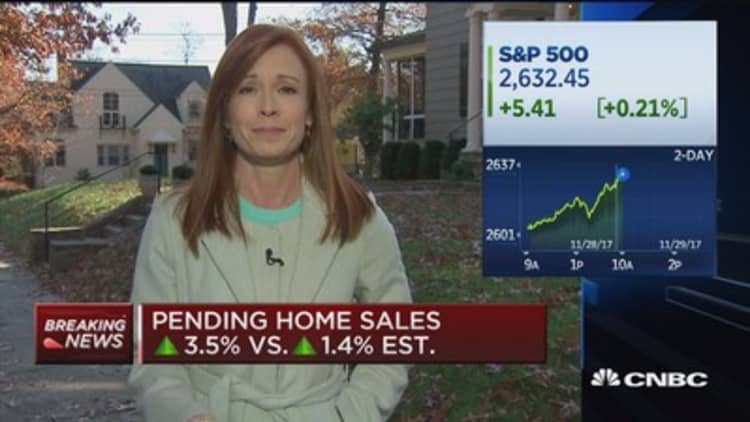
After three months of weaker volume, homebuyers returned to the market in October, especially in the South.
The pending home sales index, which measures signed contracts to buy existing homes, rose 3.5 percent for the month, but is still 0.6 percent lower than October 2016. That is the highest level since June, but September's reading was revised down.
The index, from the National Association of Realtors, is a forward-looking indicator for closed sales one to two months out.
Sales were strongest in the South, jumping 7.4 percent for the month and 2 percent compared with a year ago. That was likely due to pent-up demand after two major hurricanes at the end of the summer. Realtors in Houston have remarked at how quickly the market bounced back following the devastating effects of Hurricane Harvey.
Sales were higher in the Northeast by 0.5 percent monthly, and in the Midwest by 2.8 percent. In the West, where prices are highest and inventory is slim, homes experienced a monthly decline of 0.7 percent. All three regions were lower compared with October 2016.
"Home shoppers had better luck finding a home to buy in October, but slim pickings and consistently fast price gains continue to frustrate and prevent too many would-be buyers from reaching the market," said Lawrence Yun, chief economist for the Realtors.
Yun is now predicting total home sales for 2017 will come in at 5.52 million, up just 1.3 percent compared with 2016. He blames the weakness entirely on a lack of listings.
"Existing inventory has decreased every month on an annual basis for 29 consecutive months, and the number of homes for sale at the end of October was the lowest for the month since 1999," said Yun. "Until new home construction climbs even higher and more investors and homeowners put their home on the market, sales will continue to severely trail underlying demand."
While sales of existing homes have been weak for much of this year, sales of newly built homes have been surging in the past few months. The latest reading for October, which also measures signed contracts, had new home sales up nearly 19 percent compared with a year ago, according to the U.S. Census.
Builders are benefiting from the shortage of existing homes for sale, but homebuyers are not. Home price gains are accelerating again, and affordability is weakening, especially at the low end of the market, where demand is strongest.
"In 2018, strong price growth will be met with higher interest rates in addition to possible tax changes that could make homeownership even more unaffordable than it is now," said Nela Richardson, chief economist at Redfin.
"Buyer demand is still high, even as homes become more expensive. Thus the biggest risk of 2018 is not a bubble in home prices, but that fewer middle-class buyers will be able to keep pace with price increases," Richardson added.


